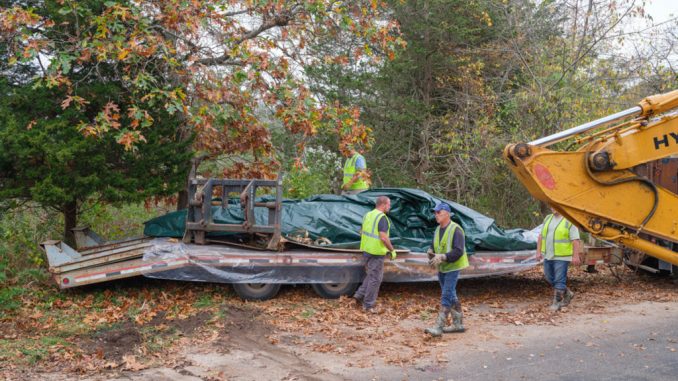
Robert A. DiGiovanni Jr., founder and chief scientist of the Atlantic Marine Conservation Society in Hampton Bays, said an initial necropsy of the minke whale that died in Goose Creek shows the death “is consistent with other species of this type where disease were a factor.”
He said the 20-foot, 4,360-pound animal “was compromised when it entered the creek.”
He said he was being very careful with his words because more work has to be done to precisely say why the whale died. He said there were “biological causes” consistent with Infectious diseases.
“We took samples of the brain,” he said. “You see lesions and inflammation in the brain. We have similar findings in other animals. It did have some food in the stomach… Samples will be sent out for pathology.”
A paddleboarder discovered the whale in the creek Thursday afternoon and reported it to Southold Town police. Multiple agencies responded to the scene to evaluate the whale, which had become stranded as the tide was outgoing. The whale was sedated and died overnight.
The Southold Town Highway Department removed the whale Friday and moved it the town landfill for the necropsy.
The examination was part of an unusual mortality event ongoing for minke whales in the region, the conservation society said in a media release. A UME is defined as “a stranding that is unexpected, involves a significant die-off of any marine mammal population; and demands immediate response,” according the Marine Mammal Protection Act.

The Atlantic Marine Conservation Society was alerted to the whale through the New York State Marine Mammal and Sea Turtle Stranding Hotline at 631-369-9829. Any residents who find a stranded marine mammal or sea turtle are urged to call the hotline.
“Please remember that dolphins, porpoises, and whales are protected by the Marine Mammal Protection Act, which makes touching, feeding, or otherwise harming these animals illegal,” the conservation society notes.
An initial examination determined the animal was a sub-adult male and was noted to be thin in appearance.
“Due to the time of day, environmental conditions, and safety for the responders and the whale, sedation was administered to the whale to help relieve any suffering or pain it may have been experiencing,” the conservation society said in a media release. “The whale was in a location that prevented safely moving or providing additional medical intervention, so the decision was made to monitor the whale overnight by local officials.”
The New York State Department of Environmental Conservation and the National Oceanic and Atmospheric Administration Fisheries assisted the conservation society.
The Long Island Advance reported a dead whale was spotted in surf on Fire Island near Old Inlet Saturday.

